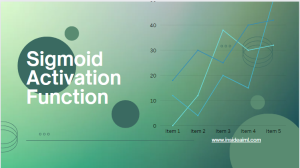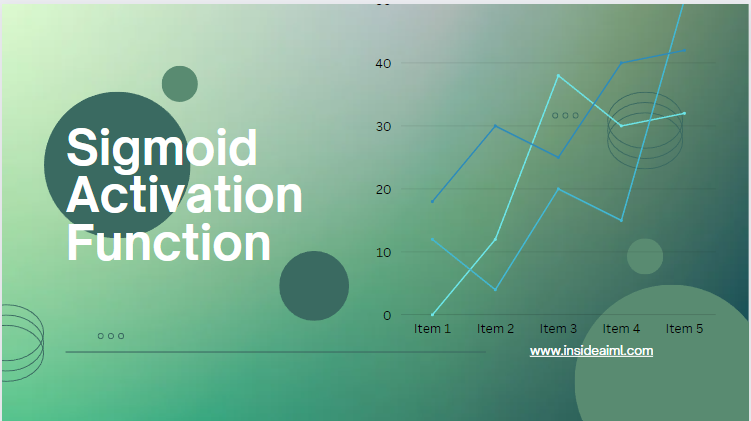The Sigmoid function is the most frequently used activation function in the beginning of deep learning. It is a smoothing function that is easy to derive and implement.
The name Sigmoidal is derived from the Greek letter Sigma, and when it is plotted, appears as a sloping “S” across the Y-axis.
In the beginning stages of deep learning, the sigmoid function is used. This smoothing function is useful and easy to derive. The curve is “S”-shaped along the Y axis, therefore “Sigmoidal.”
According to the plot, the sigmoid’s output lies smack in the center of the open interval (0,1). Although imagining the scenario in terms of probability can be helpful, we shouldn’t take that to be a guarantee. The sigmoid function was widely accepted as the best option before the development of more advanced statistical methods. Consider the speed at which a neuron transmits signals through its axons. The center of the cell, where the gradient is at its sharpest, is the most active part of the cell. Slopes of the neuron contain the inhibitory components.
The sigmoid function could use some tweaking.
- As the input moves away from the origin, 1) the gradient of the function approaches 0. All neural network backpropagation uses the chain rule of the differential. Calculate the relative weight differences between the objects. The difference between chains becomes insignificant after sigmoid backpropagation. Eventually, the weight(w) will have a minor effect on the function of the loss function that iteratively passes through multiple sigmoid activation functions (which is possible). It’s possible that this setting promotes a healthy weight. This represents a case of gradient saturation or dispersion.
- The weights are updated inefficiently if the function’s result is not 0.
- It takes more time for a computer to complete a calculation involving a sigmoid activation function because of the exponential nature of the calculations involved.
The Sigmoid function, like any other tool, has its limitations.
The Sigmoid Function has several useful applications.
With its smooth progression, we can prevent any abrupt changes in the final product.
To facilitate comparison, the output of each neuron is normalized so that it falls within the range of 0 to 1.
As a result, we can improve the accuracy of the model’s predictions and bring them closer to 1 or 0.
A summary of some of the problems with the sigmoid activation function follows.
It seems especially vulnerable to the issue of gradients fading away over time.
Power operations that take a while to complete add to the overall complexity of the model.
Would you mind giving me a hand by showing me how to create a sigmoid activation function and its derivative in Python?
Thus, the sigmoid activation function is easily determined. This formula requires a function.
If not, then the Sigmoid curve serves no useful purpose.
It is agreed that the sigmoid activation function is the one whose value equals 1 + np exp(-z) / 1. (z).
Sigmoid prime(z) represents the derivative of the sigmoid function:
In other words, the function’s predicted value is sigmoid(z) * (1-sigmoid(z)).
Basic Sigmoid Activation Function Code in Python
Bookcases Import matplotlib. pyplot: “plot” imports NumPy (np).
Create a sigmoid by giving it a definition (x).
s=1/(1+np.exp(-x))
ds=s*(1-s)
Reiterate the prior actions (return s, ds, a=np).
It follows that the sigmoid function should be plotted at (-6,6,0.01). (x)
# Center the axes with axe = plt.subplots(figsize=(9, 5)). formula. \sposition(‘center’) ax.spines[‘left’] sax.spines[‘right’]
The saxophone’s [top] spines are aligned along the x-axis when Color(‘none’) is used.
Make sure Ticks are at the very bottom of the stack.
Sticks(); / y-axis; position(‘left’) = sticks();
This code generates and displays the diagram: Sigmoid formula: y-axis: See: plot(a sigmoid(x)[0], color=’#307EC7′, linewidth=’3′, label=’Sigmoid’)
Here is an example of a plot of a and sigmoid(x[1], with room for customization: plot(a sigmoid(x[1], color=”#9621E2″, linewidth=3, label=” derivative]) will produce the desired result. Use the following piece of code to see what I mean: axe. legend(loc=’upper right, frameon=’false’), axe. plot(a, sigmoid(x)[2], color=’#9621E2′, linewidth=’3′, label=’derivative’).
Details:
The sigmoid and derivative graph resulted from the above code.
For example, the sigmoidal part of the tanh function generalizes to all “S”-form functions and makes logistic functions a particular case (x). The only distinction is that tanh(x) is not in the range [0, 1]. A sigmoid activation function value will typically fall somewhere between zero and one. The differentiable sigmoid activation function allows us to easily calculate the sigmoid curve’s slope at any two points.
According to the plot, the sigmoid’s output lies smack in the center of the open interval (0,1). Although imagining the scenario in terms of probability can be helpful, we shouldn’t take that to be a guarantee. Before better statistical methods, most people thought the sigmoid activation function was best. The rate at which neurons fire their axons is a useful metaphor for thinking about this phenomenon. The center of the cell, where the gradient is at its sharpest, is the most active part of the cell. Slopes of the neuron contain the inhibitory components.
Summary
The purpose of this post was to introduce the sigmoid function and its Python implementation; I hope you found it informative.
Data science, machine learning, and AI are just a few of the cutting-edge fields that InsideAIML covers. Take a look at this supplementary reading.


